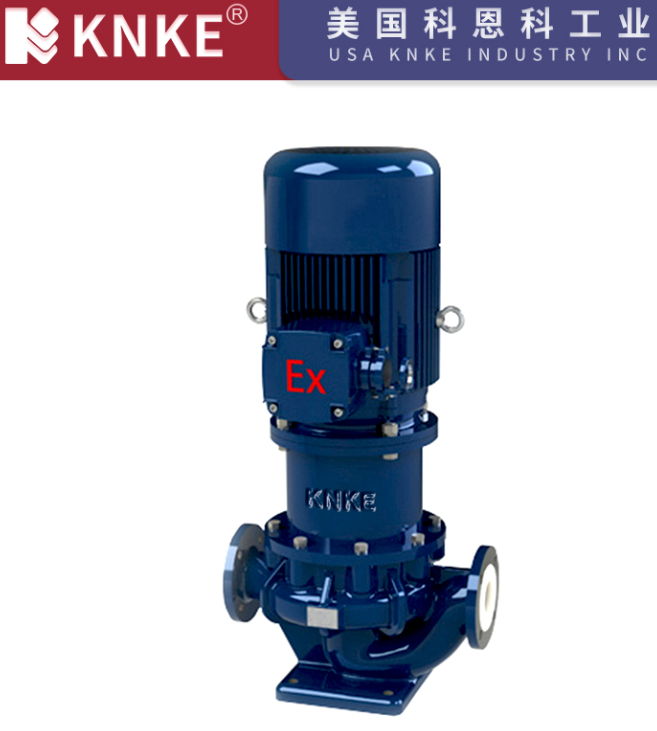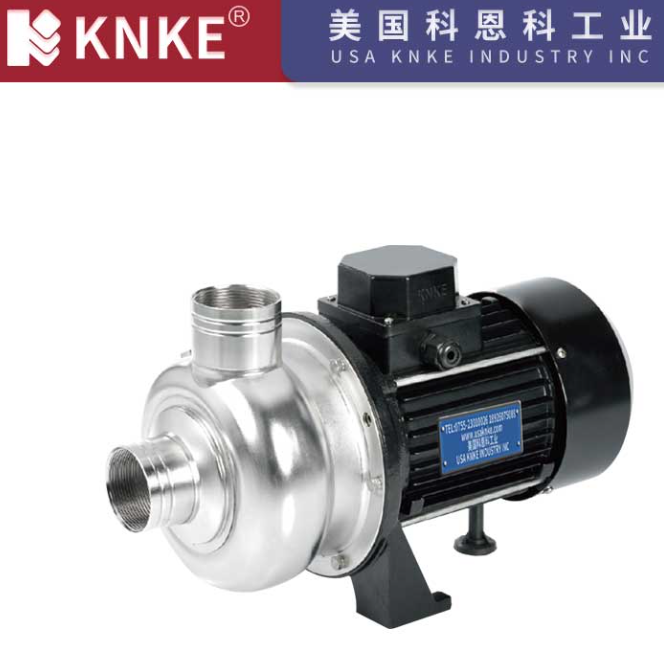Which Pump for Your Industry? Magnetic vs Centrifugal Pumps
In the field of industrial fluid transportation, centrifugal pumps and magnetic pumps are two common types of pumping equipment. Although both belong to the category of vane pumps, they differ significantly in technical principles, structural designs, application scenarios, and performance characteristics. This article provides an in-depth analysis of their core differences from the perspectives of working principles, sealing characteristics, application scenarios, and offers guidance for practical engineering selection.

I. Working Principles: From “Mechanical Connection” to “Magnetic Coupling”
(1) Centrifugal Pumps: Classic Design Driven by Centrifugal Force
The core working principle of centrifugal pumps is the centrifugal force effect of the impeller. When the motor drives the pump shaft to rotate at high speed, a low-pressure area forms at the center of the impeller. Liquid is sucked into the pump body under atmospheric pressure, then thrown to the edge by the impeller blades, converting kinetic energy into static pressure energy before being discharged. Key components include the impeller, pump shaft, and mechanical seal (or packing seal), with power transmitted directly to the impeller through the pump shaft. The liquid chamber and drive end are isolated by mechanical seals, a “dynamic seal” design where the precision and durability of the seals directly affect the pump’s reliability.
(2) Magnetic Pumps: A Sealing Revolution with Non-Contact Magnetic Coupling
Magnetic pumps break through traditional mechanical connection models by adopting permanent magnetic coupling technology for power transmission. Their structure consists of three parts: an external magnetic rotor connected to the motor, an internal magnetic rotor coaxial with the impeller, and an isolation sleeve (usually made of metal or polymer materials) between them. As the external magnetic rotor rotates, it drives the internal magnetic rotor to rotate synchronously through magnetic coupling, eliminating the need for a pump shaft to pass through the liquid chamber and completely removing dynamic seal components. This “static seal” design fully encloses the liquid within the isolation sleeve, fundamentally eliminating leakage paths – a critical technological breakthrough for high-risk fields such as chemical engineering and pharmaceuticals.
II. Sealing Characteristics: From “Controlled Leakage” to “Absolute Zero Leakage”

(1) Centrifugal Pumps: Leakage Risks of Dynamic Seals
Centrifugal pump mechanical seals consist of dynamic rings, static rings, and sealing rings, achieving sealing through end-face friction. During long-term operation, gaps may form in the sealing surface due to wear, corrosion, or thermal deformation, leading to medium leakage. For harmless media like water or ordinary oil, minor leakage is acceptable; however, when transporting strong acids, alkalis, organic solvents, or toxic media, leakage can trigger safety accidents or environmental pollution. Additionally, packing-sealed centrifugal pumps require regular adjustment of packing glands or replacement of packing, increasing maintenance costs.
(2) Magnetic Pumps: Intrinsic Safety of Static Seals
The isolation sleeve of magnetic pumps fully encloses the liquid chamber, with internal and external magnetic rotors transmitting power through magnetic coupling – no moving parts penetrate the sealing interface, achieving “zero leakage” sealing. This feature makes them the first choice for transporting flammable and explosive media (e.g., gasoline, alcohol), strongly corrosive media (e.g., sulfuric acid, hydrochloric acid), and high-purity media (e.g., pharmaceutical raw materials, electronic-grade solvents). Even under high-pressure and high-temperature conditions (some models withstand temperatures up to 300°C or more), the integrity of the isolation sleeve ensures no medium leakage, significantly enhancing system safety.
III. Application Scenarios: Precise Adaptation from “General Transportation” to “Specialized Conditions”
(1) Centrifugal Pumps: Cost-Effective Choice for Routine Fluid Transportation
Centrifugal pumps are widely used in general liquid transportation scenarios due to their simple structure, low cost, and easy maintenance:
- Civil Applications: Building water supply, wastewater treatment, agricultural irrigation;
- Industrial Processes: Cooling water circulation, lubricating oil transportation, food and beverage processing (with food-grade seals);
- Energy Sector: Power plant condensate transportation, crude oil pipeline pressurization.
Their limitation lies in failing to meet high-sealing requirements, and impellers are prone to wear when transporting particle-laden media (specialized variants like slurry pumps are needed).
(2) Magnetic Pumps: Essential Solution for High-Risk Medium Transportation
The core advantages of magnetic pumps make them indispensable for specialized conditions:
- Chemical Industry: Transporting concentrated acids, caustic alkalis, organic solvents to avoid toxic medium leakage;
- Pharmaceuticals and Semiconductors: Transporting high-purity liquid medicine and deionized water to prevent contamination;
- Nuclear Industry and Aerospace: Transporting radioactive media and rocket propellants to ensure absolute sealing;
- Environmental Protection: Treating wastewater containing heavy metal ions to eliminate secondary pollution.
Additionally, some magnetic pumps use stainless steel or fluoroplastic linings to further enhance corrosion resistance, adapting to harsh chemical environments.
IV. Performance and Maintenance: Balancing Efficiency, Cost, and Reliability
(1) Efficiency and Energy Consumption
Centrifugal pumps generally have slightly higher efficiency than magnetic pumps (about 5%-10% higher) due to hysteresis and eddy current losses in magnetic coupling. However, with the application of high-performance permanent magnetic materials like neodymium-iron-boron, modern magnetic pumps have approached centrifugal pump efficiency levels (75%-85%). In high-power scenarios, the cost-effectiveness of energy consumption versus sealing safety must be comprehensively evaluated.
(2) Maintenance Costs
The primary maintenance focus for centrifugal pumps is mechanical seals, with an average replacement cycle of 6-12 months, leading to high seal costs and downtime losses. Magnetic pumps have no dynamic seal components, requiring only regular checks of bearings and lubrication systems – reducing maintenance frequency by over 60%. Note: Strong magnetic environments may cause demagnetization of magnetic rotors, and high temperatures (exceeding 150°C) can affect magnetic coupling performance – select high-temperature models according to operating conditions.
(3) Operational Characteristics
Magnetic pumps operate with low noise (usually <70dB) and minimal vibration due to no mechanical contact, suitable for environments sensitive to noise. Improper installation of centrifugal pump mechanical seals may cause excessive vibration or abnormal noise, requiring regular dynamic balance calibration.
V. Selection Criteria: Four Core Considerations
- Medium Characteristics
- Harmless, non-corrosive liquids: Prioritize centrifugal pumps to reduce costs;
- Toxic, corrosive, flammable, or high-purity liquids: Mandatory selection of magnetic pumps for safety;
- Particle-laden media: Centrifugal pumps need wear-resistant impellers; magnetic pumps require isolation sleeve strength verification (some models can handle fine particles).
- Operating Parameters
- Flow rate and head: Both cover wide parameter ranges (flow 0.1-1000m³/h, head 10-1000m) – select based on specific needs;
- Temperature and pressure: Centrifugal pumps typically withstand ≤120°C, standard magnetic pumps ≤150°C – choose special designs (e.g., cooled circulation magnetic pumps) for high-temperature conditions.
- Safety and Environmental Requirements
- Chemical parks and densely populated areas: Prioritize magnetic pumps to avoid leakage accidents;
- Compliance: For hazardous chemical transportation, adhere to standards like API 685 and GB/T 13955 – magnetic pumps more easily pass strict certifications.
- Life Cycle Cost
- Initial investment: Magnetic pumps cost 1.5-2 times more than centrifugal pumps of the same specification;
- Long-term cost: Lower maintenance costs for magnetic pumps may result in lower overall lifecycle costs (especially in high-risk scenarios avoiding accident losses).
Magnetic pumps and centrifugal pumps are not substitutes but complementary solutions for different working conditions: centrifugal pumps dominate conventional markets with versatility and economy, while magnetic pumps set technical barriers in high-risk medium transportation with zero-leakage features. As industrial automation and environmental requirements rise, demand for magnetic pumps in high-end equipment will continue to grow, while centrifugal pumps remain the mainstay for basic fluid transportation. Selection should move beyond an “either-or” mindset, instead comprehensively evaluating medium safety, operating parameters, and cost-benefit to achieve optimal matching between equipment efficiency and engineering needs.
Driven by the “Double Carbon” goal and safety production requirements, both pump technologies are continuously evolving: centrifugal pumps improve reliability through intelligent seal monitoring, while magnetic pumps develop towards high-speed, large-scale, and extreme-condition resistance. In the future, breakthroughs in material science and magnetic coupling technology will further expand their performance boundaries, providing more efficient and safer solutions for industrial fluid transportation.
